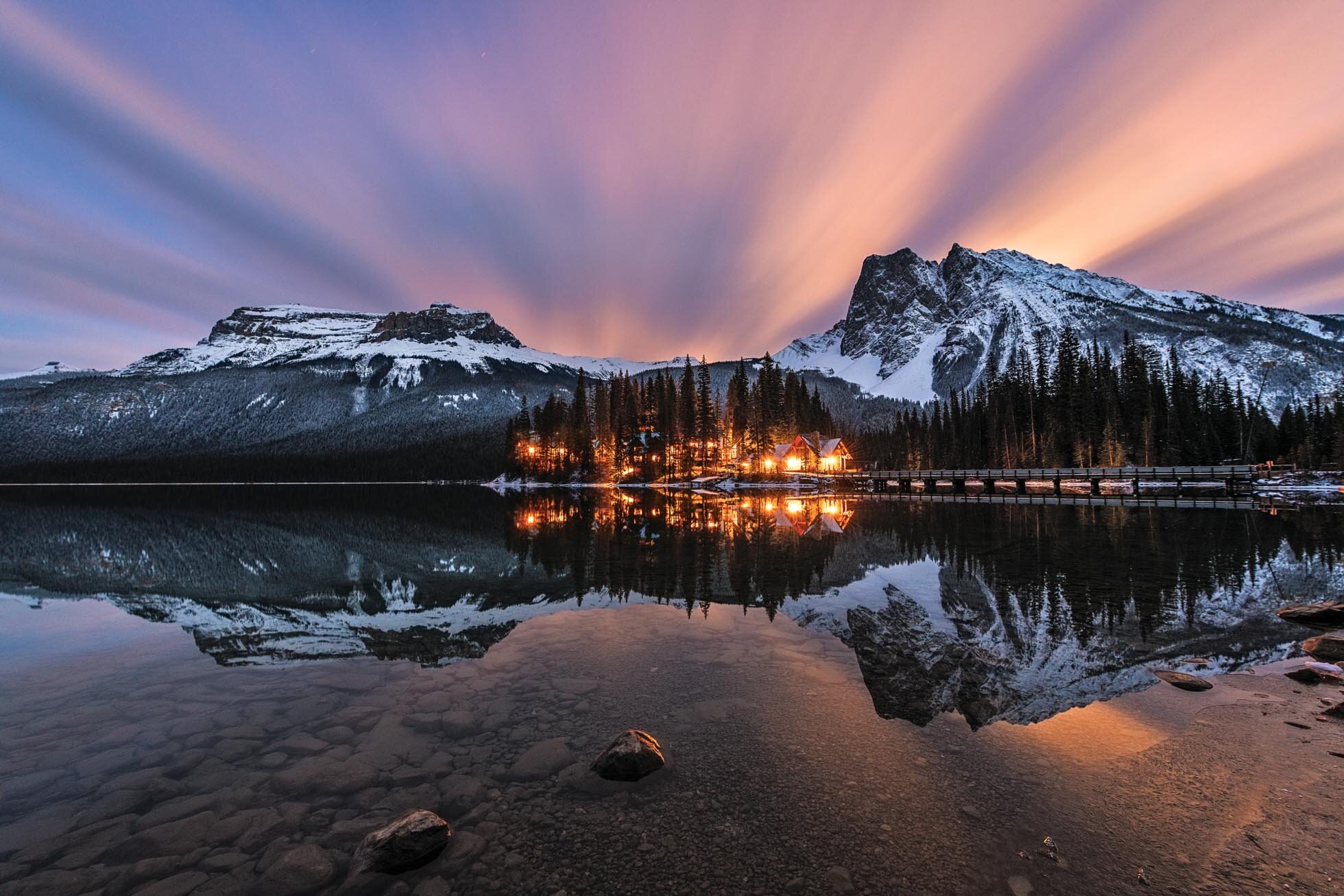One of the most compelling elements you can include in landscape imagery is a strong reflection. Reflections add interest, often create symmetry and help to add depth in a simple scene. Reflections are a great way to capture a more intriguing image when the skies are uncooperative, such as full overcast or completely clear.
Calm waters in Emerald Lake in Yoho National Park as the sun sets and moon rises.
You can find reflections in any water source that is still such as a pond, lake, calm area of a river, a puddle, or even the wet sand along the shore. Reflections of mountains, trees, city buildings and skies are all compelling subjects to find reflections of in your scenery.
Some tips for finding and capturing the best reflections and most compelling images:
1) Find Calm Water ~Calm water is a necessity for the clearest reflections. Smaller and shallower bodies of water will often be easiest to find calm water though even larger and deeper lakes can be calm enough for clear reflections if you catch them at the right times. Early morning or later evening will often be the best times for finding calm water. Check your weather forecast and choose days and times with low wind.
Pretty calm waters at Oxbow Bend in Grand Teton National Park. The 10 second exposure smoothed the water a bit.
2) Consider the light ~ The best reflections will be captured when the light is behind you and a bit to the right or left. With that in mind, be aware of how the sun can cast a shadow of your body into the scene. Unless you are going for a shadow self portrait, then go right ahead 😊
Calm waters in the Snake River with the sunrise light behind me.
Calm morning waters at Lake Marmo at Morton Arboretum with the sun behind me.
3) Find the best perspective ~ Sometimes the the reflection is obvious in the scene but other times the best reflection can take a little exploring angle and perspective. Get low and see if you can get more reflection than at eye level. It’s also important to consider how you are composing the scene to avoid chopping your main subject AND its reflection in an awkward way. Be sure to leave comfortable space above the subject and below its reflection.
The reflection of the sky and clouds in the wet sand and very shallow waters at Cannon Beach in Oregon is enhanced by my low perspective very close to the sand. Getting low also helps to add depth in the image.
4) Consider using a Graduated Neutral Density filter - The reflection is often much darker than the subject above. A graduated neutral density filter can reduce the exposure of the top of the frame to neutralize the dynamic range so you can better expose the shadowed reflection. This is especially the true in a situation where the sun is setting behind your subject and not illuminating the reflection such as in the Teton images above.
5) Experiment with long exposures ~ If the water is a bit rippled and the reflection is lacking, shooting a long exposure will smooth the water and sometimes bring out a hint of reflection as well.
This sunset at Oxbow Bend had an incredibly beautiful reflection for evening. The water was nice and calm. This is a situation where a GND could help to decrease exposure on the sky a few stops and allow the foreground to be exposed brighter without overexposing the sky.
In this scene, the water was extremely choppy from the wind in the late afternoon on a blustery November day. The 30 second exposure brought out some reflection of the mountain in Bow Lake.
I hope these tips help you capture stunning reflections in your local scenery and in your travels. If you’re looking to purchase filters for creative effects including long exposures, my go to filters are from Breakthrough Photography *. They are great quality and do not add a color cast.
Kristen Ryan is an award winning and published landscape and fine art photographer and educator residing in the Midwest suburbs of Chicago. All images are available for purchase in the Fine Art Store or by request. Kristen leads ladies landscape photography retreats in the Tetons, Chicago, and the Canadian Rockies, offers private mentoring and teaches an online landscape photography workshop, The World Around You.
*Affiliate Link











